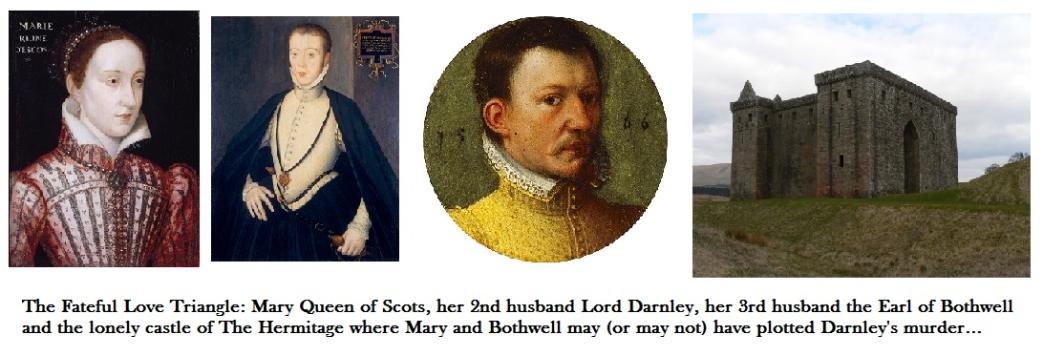MARY’S MIDNIGHT RIDE – ANOTHER EPISODE IN THE HORRIBLE HISTORY OF HERMITAGE CASTLE
The Hermitage is a remote and forbidding fortress, located in a bleak valley on Scotland’s Border with England, yet on the 15th of October 1566 it hosted an ill-starred meeting between Mary Queen of Scots and James Hepburn 4th Earl of Bothwell.
Despite the fact that both Mary and Bothwell were married to other people, the Queen and Earl were extremely close. The rugged, good looking Bothwell was a complete contrast to Mary’s current husband, the drunken, dissolute Lord Darnley, however Mary’s favour, and his own ambition, meant Bothwell had acquired many enemies at the Scottish Court.
In 1562 Bothwell’s rivals contrived to have the Earl thrown into prison but he escaped and fled to The Hermitage. With life at court so dangerous, Bothwell decided to stay in his Borders’ stronghold and devote his time to pacifying his domains, which were suffering greatly from the depredations of the notorious Border Reivers. These fierce, feuding cattle thieves refused to submit to either English or Scottish law and one of the worst offenders against the Queen’s Peace was Little Jock Elliot.
The proud and bellicose Bothwell was determined to bring the impudent Little Jock to justice so he set a trap but things didn’t go as planned. Accounts of the skirmish differ but one Border Ballad records that Elliot escaped and boasted:
“I've vanquished the Queen's Lieutenant,
And garr'd her troopers flee;
My name is Little Jock Elliot,
And wha daur meddle wi' me?”
What’s certain is that during the fight Bothwell was badly wounded in the hand, head and body. His men carried their master back to The Hermitage and sent a message to the Queen informing her that her favourite was not expected to last the night. As luck would have it, Mary was at Jedburgh, which was only 25 miles from The Hermitage, but the road over the bleak, windswept hills was fraught with dangers. These perils ranged from the deep mires that could swallow a horse and rider, to the murderous reivers who preyed on unsuspecting travellers regardless of their rank.
Despite these hazards Mary lost no time in saddling a horse and setting off to comfort the wounded Bothwell. She rode hard, and was soon at her favourite’s side, but when it was clear that the Earl wouldn’t die after all she left. In total, Mary spent less than two hours in Bothwell’s company but the return journey to Jedburgh almost proved fatal to the queen. Exhausted by her long ride, and recent pregnancy, Mary fell from her horse and was soaked to the skin. She contracted pneumonia but she too survived.
Considering the dangers of the journey, and the brief time Mary spent at The Hermitage, many have insisted that only an adulterous lover would risk such a foolhardy visit to a volatile and violent man like Bothwell. Modern historians have cast doubt on this assumption but, just a few months after her ride to The Hermitage, Mary’s husband was murdered.
On the 9th February 1567 two explosions destroyed Lord Darnley’s lodgings in a house near the royal palace of Holyrood and the body of the Queen’s husband was found in the grounds. On the 15th May that same year Mary married Bothwell after the Earl had ‘kidnapped’ the Queen and taken her to Dunbar, so was the plot to murder Darnley hatched during their meeting at The Hermitage?
Certainly Mary and Bothwell’s enemies believed the Earl had ordered the assassination with the tacit approval of the Queen. Bothwell was charged with Darnley’s murder and though he was acquitted he was forced into exile. The Earl died, insane, in a Danish dungeon in 1578. Nor did Mary escape the wrath of her foes. The scandal of Darnley’s death and her marriage to Bothwell set the tragic Queen of Scots on the long road that would end, twenty years later, on an English scaffold.
For more duplicitous double dealing in Tudor Times, you can read a sample chapter of my novel The Devil’s Band on my Facebook page https://www.facebook.com/thedevilstonechronicles/book_preview
